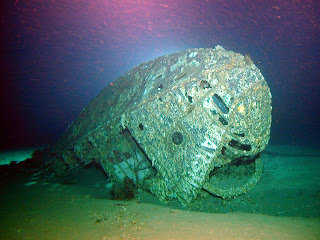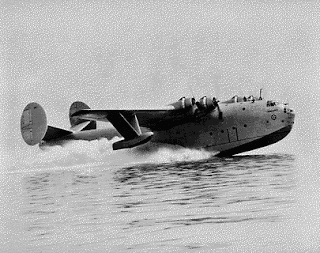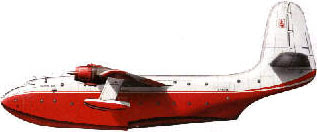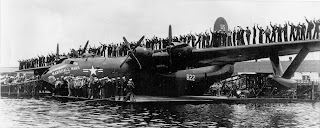Flightdeck Friday – Flying Boats
Martin XPB2M-1 & JRM Mars
 August 2004. While conducting a survey in Hawaiian waters of a Japanese mini-sub site, a NOAA minisub crew stumbled upon a large debris field, consisting of what appeared to be a seaplane keel and wings. Maneuvering the sub around the crew was able to clearly read the word “< ?xml:namespace prefix = st1 />
August 2004. While conducting a survey in Hawaiian waters of a Japanese mini-sub site, a NOAA minisub crew stumbled upon a large debris field, consisting of what appeared to be a seaplane keel and wings. Maneuvering the sub around the crew was able to clearly read the word “< ?xml:namespace prefix = st1 /> famous of the five JRM-3 Mars flying boats operated by the Navy during and after WWII. Based on the West Coast, these aircraft ranged the Pacific, ferrying passengers, freight and when necessary, bringing wounded back to the States. An extraordinarily large aircraft, the Mars was the largest operational flying boat built and second in size only to Howard Hughes’ “Spruce Goose” (the Goose weighed in at 200 tons gw while the Mars would weigh in at 165).
famous of the five JRM-3 Mars flying boats operated by the Navy during and after WWII. Based on the West Coast, these aircraft ranged the Pacific, ferrying passengers, freight and when necessary, bringing wounded back to the States. An extraordinarily large aircraft, the Mars was the largest operational flying boat built and second in size only to Howard Hughes’ “Spruce Goose” (the Goose weighed in at 200 tons gw while the Mars would weigh in at 165).
Throughout the 1920’s and -30’s, the Navy spent considerable effort in the development of long-range, sea-based patrol planes. Likewise, the commercial air travel industry also spent considerable time/effort as the “flying boats” offered the best possibilities for carrying large payloads long distances across the Atlantic and Pacific (the latter especially). Several major companies were involved — Boeing, Sikorsky and Martin, to name a few. Boeing, of course, came to be known for its famous Clippers, which have come to define the exotic and romantic aspects of air travel in the late 1930s.
 Over at Martin, considerable work was accomplished for the Navy in development of patrol aircraft, notably the PBM Mariner. While Consolidated was busy developing the soon to be famous PBY Catalina, Martin was contracted to build a huge long range seaplane which was heavily armed and envisioned as a” dreadnaught of the air.” Starting with the PBM as a baseline, Martin scaled up the design to produce a prototype, the XPB2M-1 Mars.
Over at Martin, considerable work was accomplished for the Navy in development of patrol aircraft, notably the PBM Mariner. While Consolidated was busy developing the soon to be famous PBY Catalina, Martin was contracted to build a huge long range seaplane which was heavily armed and envisioned as a” dreadnaught of the air.” Starting with the PBM as a baseline, Martin scaled up the design to produce a prototype, the XPB2M-1 Mars.
This was a huge aircraft for the time — weighing in at 140,000 lbs with a wingspan of 200 ft, the Mars was powered by four 2,000 hp Wright R-3350 engines turning laminated wood props. For comparison purposes, Boeing’s XB-29 (which first flew in 1942) was 105,000 lbs and had a wingspan of 142 ft. The plane’s interior was laid out with separate mess rooms, berths, and washrooms for officers and enlisted men. Its commander had a private stateroom and issued his orders from a desk behind the pilots’ seats. A huge bomb-bay, located in the hull underneath the wings, contained racks capable of holding five 1,000-pound bombs each. When it came time to drop them these could slide out on either side along the lower edge of the wing.
Mars was powered by four 2,000 hp Wright R-3350 engines turning laminated wood props. For comparison purposes, Boeing’s XB-29 (which first flew in 1942) was 105,000 lbs and had a wingspan of 142 ft. The plane’s interior was laid out with separate mess rooms, berths, and washrooms for officers and enlisted men. Its commander had a private stateroom and issued his orders from a desk behind the pilots’ seats. A huge bomb-bay, located in the hull underneath the wings, contained racks capable of holding five 1,000-pound bombs each. When it came time to drop them these could slide out on either side along the lower edge of the wing.
< ?xml:namespace prefix = o />
 Initial taxiing came to an abrupt end on the Friday before
Initial taxiing came to an abrupt end on the Friday before
Long before either Mars transports or the Model 193 could have been ready, the tide had turned in the
In January 1945 the Navy ordered twenty more Mars transports, now designated JRM-1. In comparison to the original, their hulls were to be six feet longer and the split PBM-style tail replaced by a single 44-foot vertical fin. Fewer internal bulkheads and an overhead hoist would assist cargo-handling. Maximum take-off weight grew to 148,500 pounds. Recalling the China Clippers a decade before, the first JRM-1 was christened the “Hawaii Mars” in July 1945. It crashed just two weeks later in a landing accident on
replaced by a single 44-foot vertical fin. Fewer internal bulkheads and an overhead hoist would assist cargo-handling. Maximum take-off weight grew to 148,500 pounds. Recalling the China Clippers a decade before, the first JRM-1 was christened the “Hawaii Mars” in July 1945. It crashed just two weeks later in a landing accident on
The Navy purchased its sixth and last Mars with Wasp Major engines, which enabled the single JRM-2 to carry an extra 18,000 pounds of cargo on the San Francisco-to-Hawaii run. The four earlier planes were eventually re-engined with Wasp Majors as well and designated JRM-3’s. All five served in the Pacific, carrying military personnel, Korean-war wounded, blood plasma, and other priority cargo over the same routes as were once flown by the glamorous clippers. Like them, they were duly christened for Pacific destinations: Philippine, Marianas,
A fire destroyed the Marshall Mars in 1950 not long after setting a record for carrying 308 passengers on a typical California-Hawaii run. This record would stand until the flight of the 747 almost two decades later. The other four JRM’s served in the Navy (with VR-8 in the Naval Air Transportation Service or NATS) until 1956. They were then sold as surplus to Forest Industries Flying Tankers Limited, a Canadian firm, for a mere $100K. Currently, two still survive – the Philippine Mars and Hawaii Mars (the Marianas Mars crashed in an accident in 1961, and the Caroline Mars was destroyed in a hurricane a year later) and are used to drop 60,000-pound loads of water and fire retardant on Western forest fires.
General characteristics
- Crew: four (with accommodations for a second relief crew)
- Capacity: 133 troops, or 84 litter patients and 25 attendants
- Payload: 32,000 lb (15,000 kg) of cargo, including up to seven jeeps
- Length: 117 ft 3 in (35.74 m)
- Wingspan: 200 ft 0 in (60.96 m)
- Height: 38 ft 5 in (11.71 m)
- Wing area: 3,686 ft² (342.4 m²)
- Empty weight: 75,573 lb (34,279 kg)
- Loaded weight: 90,000 lb (40,820 kg)
- Max Takeoff Weight: 165,000 lb (74,800 kg)
- Powerplant: 4× Wright R3350-24WA Duplex Cyclone 18-cylinder radial engines, 2,500 hp (1,865 kW) each
Performance
- Maximum speed: 221 mph (356 km/h)
- Range: 4,300 nautical miles (5,000 miles or 8,000 km)
- Service ceiling: 14,600 ft (4,450 m)
- Rate of climb: ft/min (m/s)
- Wing loading: lb/ft² (kg/m²)








In 1955 I flew the Mars from Oakland to Honolulu. I had just
completed “P Boat” training and was going to base ops at Barbers Point. The flight took 13 hours at 5000 feet., carried 40
passangers and some freight. Speed was 145 kts! It was a
choice of the Mars or a R5d sitting on nylon troop seads for 11 hours!
I was on a launch that took Edward Teller and Navy Captain Parsons off the Hawaii Mars in Saipan harbor, they were on their way to Tinian to fulfill the Manhaten project. Although I’m not absolute on the date I thought it was 7/31/45. That would coinside with 8/6/45. There were only three men that that got off the plane but I don’t know who the thir’d was. I have never seen any article that gives the Hawaii Mars credit for being part of the Manhten project. I have pictures but don’t know how to send them.
While serving in the US Navy at Tanapag Harbor, Saipan from Octobert, 1945 – June ’46, I had the pleasure of keeping close company to the HAWAII MARS. My duty was skipper of Crash Boat, CB-1 and we cleared the water for all landings and take-offs of the flying boats. It was a thrill to see the huge plane up close. I was only 18 then.
My dad, Leslie Eugene Taylor, was a radioman on the Marshall Mars when it went down off Hawaii in, I believe, 1950.